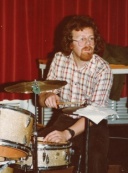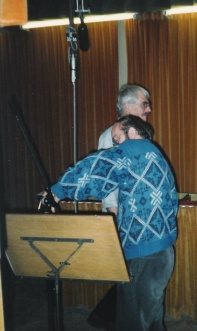Another
composition of mine is called "Sawatdee",
which is the Thai greeting. It also means "fortune" or
"prosperity" and although the tune itself has little to do with
Thailand, this seemed a good enough title. On the picture below you see the
registration room of studio 8 and Ferry Sluyter who plays a great flute- and tenorsaxsolo on "Sawatdee",
which you will hear if you click the photo.

|

|
Also our drummer and colleague Hugo Vogel composed a tune and arranged it
too. I added a counter-melody I am playing on synthesizer. It is a beautiful
tune, so although it is not mine, I wanted it on these pages as well. There
are compositions of other bandmembers too on this
site, with their permission.
By clicking the photo you
can hear this tune. Hugo named it "Whisper" , refering to Benny Golson's
"Whisper Not", although musically these tunes have no
relationship whatsoever (in case you are trying to discover it).
|
Hugo Vogel didn't stop
there. He can also find his way on a piano and started to take up music
seriously and is a composer now. He has his own site with music examples.
My brother Gerard lives in Amstelveen, where Hugo was born in 1947.
Coincidently Hugo's brother played a few times with my brother in a
jazz-combo - now, how big is the chance of that happening!? But it did.
Hugo's father is the wellknown choirconductor
and composer Willem Vogel whom I also have met in my work as a sound
engineer.

|
Here
is one more recording of the PT-band. More about this recording is on the
chapter about what I recorded at home
during that period.
|
|
More pictures
of the PT-band can be admired on the photopages via
the link below.

|
I
was also the technician on a program called "Walhalla Symfonie" (Walhalla Symphony), specials where I
could use my skills on music-montages, but this time with the help of synthesizers
(ARP 2500 en 2600) and other special equipment (like the Publison Pitchshifter and Synton Vocoder). It was an
idea of KRO producer Theo Stokkink and it was
broadcast on "Hilversum 3" (like BBC-Radio 1). It was a 2-hour
program, the first hour was just called "Walhalla" and the second
hour was "Walhalla Symfonie".
|

|
It started
4-okt-1981 and 34 symphonies were made, most of them by me. Not all of
them, because in 1982 the SVEM started and I did radio plays too, so I was
very busy and two colleagues of mine did some symphonies too. That first
symphony took a long time to make. The idea was 6 hours montage for it, but
we actually worked from 9 in the morning till 2 o'clock the next morning
(with two breaks). After that we had two days for one hour symphony.
I also produced one Symphony myself. It was all about love - the central
theme for most songs. Every symphony opened with an original composition
by a Dutch synthesizer artist always using the Walhalla theme. I composed my
own and used three sequences. The first two sequences I made at home on my Wersi organ (!) and later added some elements on the ARP
2600. For a third sequence I used the rhythm track of my arrangement of the
opening theme of a German SF TV-series called: "Alpha Alpha"
(which is on the next page). I made a new tune with this 5/4. I also used my
own Korg MS-20 in this piece.
Here is the opening, with Theo Stokkink reading a
fragment from a book by Midas Dekkers. The main
tune of the program Walhalla had to be used as well, but I have no idea which
music that is.
In 1983 there were 4 more symphonies
after a break of 14 months. Among them one of the best episodes I made. It
was a journey from Europe to Japan in music, called "Japan
Express(ion)". I think it was Wybo Goslinga (from the
Dutch magazine on electronic music: Sonic Report) who used his own record
collection (I am sure it was him, because I recently found his site!). It was
my task to make it into one "symphony". But we also used a part of
my "muzikollage".
We rented an EMU Emulator 1 and used it for a few effects, but else only
tape-editing was used and some reverb-echo machines. Computers for
audio-editing weren't there yet. We worked a few days on this program. I am
sorry I can not put this entire program online because
of rights, but a few clips can't hurt.
"Walhalla Symfonie" and radio documentaries were not enough to
be promoted from program engineer A to "head" program engineer
(senior or chief engineer). For that I should become a music engineer. As a
test I had to make a mix from a very bad recorded 16-track tape. I didn't do
very well, because I was listening to the music and didn't care very much how
it sounded - if I were a producer I would start with a good recording and not
fix a bad recording afterwards, but for radio you have to make something good,
even in terrible circumstances - I didn't like that at all.
|

|
But later I was promoted
anyway, because I started doing radio plays. This was very nice, because I
could be inventive and come up with all kinds of solutions for really very
strange requests from directors. Also for the radioplays
I used synthesizers and other specialized soundeffects
equipment. The radio plays were sometimes very 'avant
garde'.
The photograph on the
left is me setting up the microphones for actor René Lobo. (in the early
90's)
At the same time I
started doing something else. With Theo Rijsdijk
and Fred de Beer, two colleagues who were older than I and more
experienced, I formed a workgroup to start the S.V.E.M., an electronic
studio for musicproduction and radioplays. This studio was opened in 1982. More about
this studio and the music I made there in the next chapter.
|
TROS and KRO had programs
for amateur musicians and in 1982 they broadcast a special of 10 episodes
only with music made by program engineers. They called this program "Tussen de Schuiven"
(between the sliders) - it's a word joke. With the expression
"between the sliding-doors" is meant people who perform at home for
their own family, so sliding doors are used as stagecurtains
and between the sliding doors is the stage itself. We were all soundengineers, who use channelfaders
of mixingconsoles, also known as ... sliders,
hence: "between the sliders"
The
PT-band was in one of the programs, my dear colleague Beer Gertenbach was in another episode and I made a few
arrangements for him. Actually Beer is the only one of us who already had
professional experience. As Beer Bossu he
sang in musicals and is heard on several records. He became a program
engineer and did radio plays too. But he also had his own radioshow
which he presented and produced. He is a fan of Doris Day and calls her
every year on her birthday.
I never knew there was a picture of the recording session, but when Beer saw
this site he sent me the photo you see below. The three recordings we made
for the TROS-KRO program can be heard here.
Beer Gertenbach
is on the right of this photo. Next to him Hans Rikkert
de Koe, then me and the guy on the right is Egbert Schoenmaker, at present organist of the Simon-and-Judas church in Ootmarsum. I worked with the NOB just for a short time.
I did the arrangements of the songs above. In fact there is a demoversion of "By the light of the silvery
moon" in the chapter called At home
earlier.
The first two songs on this page are with the PT-band and the singing
group.
On the third song, "Mist in Amsterdam" I play grand piano (dubbed
twice) and accordion. I am not a pianist (or a singer!) but I bluff my way
through it ;-)
In another episode of the
TROS-KRO program Hugo Vogel, Paul Schoenmakers and
I played with guitarist John Evers.
I don't have a photo of John Evers, who is a very good guitarist and still
plays a lot. With the John Evers Band we recorded three songs. Rob Gerritsen, another colleague is singing in
"Follow you" and wrote the lyrics for that song. John Evers
composed it.
Our bassplayer Paul Schoenmakers wrote "Rockels"
- quite a different composition than the one I made, which is called "Lepus".
The songs were not mixed to
our satisfaction. It was done by a technician who was in a learning stage.
Unfortunately when we wanted Hugo Vogel to remix these songs, the tape was
erased. I did some equalizing techniques to lift the singing above the rest
of the instruments, but even that was hard to do, but it helped a little
anyway.
The song Lepus I first recorded on the Wersi
Orion organ. This recording is in the At home earlier section.
|
![]()
![]()